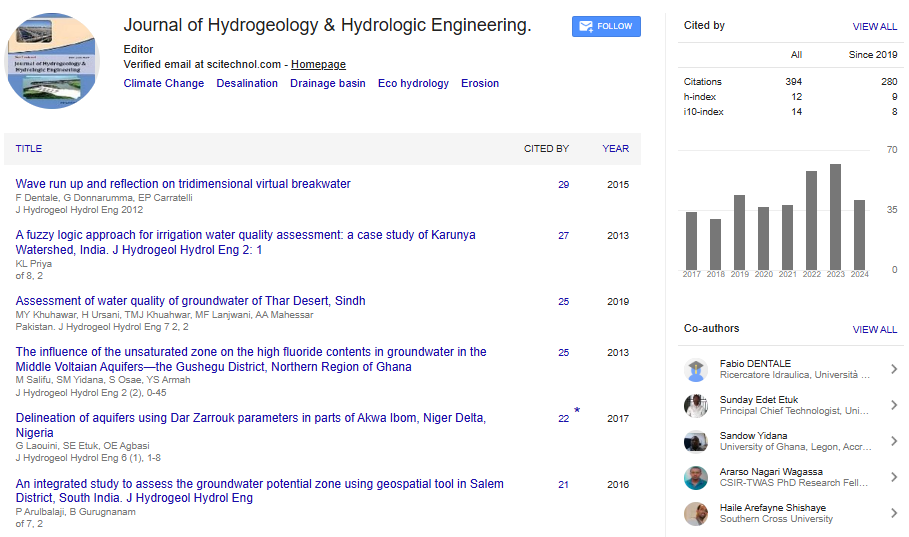Commentary, J Hydrogeol Hydrol Eng Vol: 13 Issue: 3
Developing a Comprehensive River Simulation Model: Methodologies, Applications, and Future Directions
Yusuf Sermet*
1Department of Agriculture and Environment, The University of Western Australia, Crawley, Australia
*Corresponding Author: Yusuf Sermet,
Department of Agriculture and
Environment, The University of Western Australia, Crawley, Australia
E-mail: sermety29@gmail.com
Received date: 27 May, 2024, Manuscript No. JHHE-24-144605;
Editor assigned date: 30 May, 2024, PreQC No. JHHE-24-144605 (PQ);
Reviewed date: 13 June, 2024, QC No. JHHE-24-144605;
Revised date: 21 June, 2024, Manuscript No. JHHE-24-144605 (R);
Published date: 28 June, 2024, DOI: 10.4172/2325-9647.1000326
Citation: Sermet Y (2024) Developing a Comprehensive River Simulation Model: Methodologies, Applications, and Future Directions. J Hydrogeol Hydrol Eng 13:3.
Description
River systems are dynamic and complex, requiring detailed analysis and modeling to understand their behavior and to predict changes under various scenarios. A comprehensive river simulation model is an invaluable tool for hydrologists, environmental scientists, and water resource managers. This article explores the methodologies used in developing river simulation models, their applications, and potential future directions for research and development. Developing a river simulation model involves several key steps and methodologies. The first step is data collection. Accurate data on river flow, sediment transport, water quality, and biological parameters are essential. This data is usually obtained from field measurements, remote sensing technologies, and historical records. Modern technologies such as Geographic Information Systems (GIS) and satellite imagery have significantly improved the precision and availability of this data.
Once data is collected, the next step is selecting the appropriate modeling approach. There are several types of river models, including hydrodynamic models, water quality models, and ecological models. Hydrodynamic models, such as the widely used HEC-RAS (Hydrologic Engineering Centers River Analysis System), simulate the flow and movement of water in river systems. Water quality models, like QUAL2K, focus on the chemical and physical characteristics of river water. Ecological models, such as CASiMiR, simulate the interactions between riverine organisms and their environment. Model calibration and validation are essential steps in the modeling process. Calibration involves adjusting model parameters until the model outputs match observed data. Validation involves testing the calibrated model against a separate set of data to ensure its accuracy and reliability. Statistical methods and sensitivity analysis are often employed during these steps to ensure the model’s robustness.
River simulation models have a wide range of applications in environmental science and water resource management. One primary application is in flood risk assessment and management. Hydrodynamic models can simulate flood events, helping to identify flood-prone areas and to develop mitigation strategies. These models are also used in designing and evaluating flood control structures such as levees and dams. Another significant application is in water quality management. Water quality models help in assessing the impact of pollutants on river systems. They can simulate the dispersion and transformation of pollutants, providing insights into the effectiveness of pollution control measures and helping to develop water quality management plans.
Ecological models play an essential role in biodiversity conservation and habitat restoration. By simulating the interactions between species and their environment, these models can predict the impact of environmental changes on riverine ecosystems. This information is essential for developing conservation strategies and for evaluating the potential effects of habitat restoration projects. River simulation models are also used in climate change studies. They can simulate the impact of changing precipitation patterns, temperature, and other climate variables on river systems. This information is vital for developing adaptation strategies to mitigate the effects of climate change on water resources.
The field of river simulation modeling is continually evolving, with several exciting developments on the horizon. One promising area of research is the integration of different types of models to create more comprehensive and accurate simulations. For example, integrating hydrodynamic, water quality, and ecological models can provide a more holistic understanding of river systems. Another promising development is the use of machine learning and Artificial Intelligence (AI) in river modeling. These technologies can analyze large datasets more efficiently and can identify patterns and relationships that may not be apparent through traditional methods. Machine learning algorithms can also improve model calibration and validation processes, making models more accurate and reliable.
 Spanish
Spanish  Chinese
Chinese  Russian
Russian  German
German  French
French  Japanese
Japanese  Portuguese
Portuguese  Hindi
Hindi 
